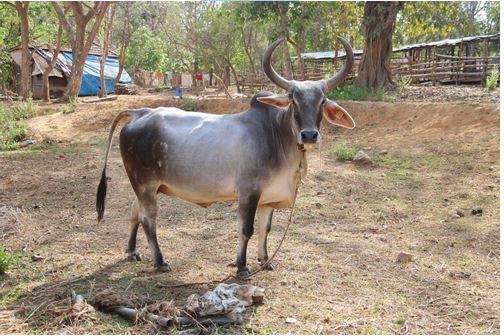




Copyright infringement not intended
Picture Courtesy: en.wikipedia.org
Context: India imports Brazilian bull semen to boost milk production by enhancing native breeds' genetics, aiming for higher yields through artificial insemination.
Key Highlights
|
Gir and Kankrej Cattle Breeds |
|
|
Gir Cattle |
●Gir cattle, also known as Gyr, have their origins in India. They are one of the principal Zebu breeds. ●Known for their distinct hump, long ears, and a well-developed dewlap. ●Coat colours vary, including shades of red, white, and spotted patterns. ●Adaptability to tropical climates and resilience to extreme weather conditions. ●Gir cows are recognized for their high milk-producing capabilities, making them a valuable breed in the dairy industry. |
|
Kankrej Cattle |
●Kankrej cattle, also known as Bannai, come from the region of Kankrej in the state of Gujarat, India. ●Medium to large-sized animals with a well-built body structure. ●Distinctive lyre-shaped horns and a hump over the shoulders. ●Typically have silver to dark grey coat colour. ●Known for their adaptability to arid and semi-arid climates, making them suitable for various agricultural practices. ●While Kankrej cattle are used for dairy purposes, they are also recognized for their strength and are employed as draft animals in agriculture. ●Kankrej cattle are listed as a breed of cattle that needs conservation due to factors like crossbreeding and changes in agricultural practices. |
Government Milk Production Targets
Brazil's Role and Expertise
Genetic Enhancement Project
Resistance and Concerns
Embryo Transfer Discussions
|
India-Brazil Relations ●The collaboration between India and Brazil extends beyond this specific initiative. Both countries share a close and multifaceted relationship, cooperating in various areas such as animal husbandry, dairy, and trade. ●The bilateral trade relationship has been steadily growing, with ambitious targets to increase two-way trade to $50 billion by 2030. Memorandums of Understanding (MoUs) signed since 2008, particularly in the domain of animal husbandry, underscore the commitment to collaboration. ●The joint declaration between Brazil's Ministry of Agriculture, Livestock and Food Supply (MAPA) and India's Department of Animal Husbandry and Dairying (DAHD) aims to streamline the process. Commercial contracts between Indian buyers and Brazilian sellers add a layer of organization to the import process. |
Conclusion
Must Read Articles:
WORLD MILK DAY: https://www.iasgyan.in/daily-current-affairs/world-milk-day
|
PRACTICE QUESTION Q. Technology can play a role in improving efficiency and sustainability in milk production. For example, the use of artificial insemination and improved breeding practices can help to increase milk yields. However, it is important to ensure that these technologies are accessible and affordable for all farmers. |








© 2025 iasgyan. All right reserved